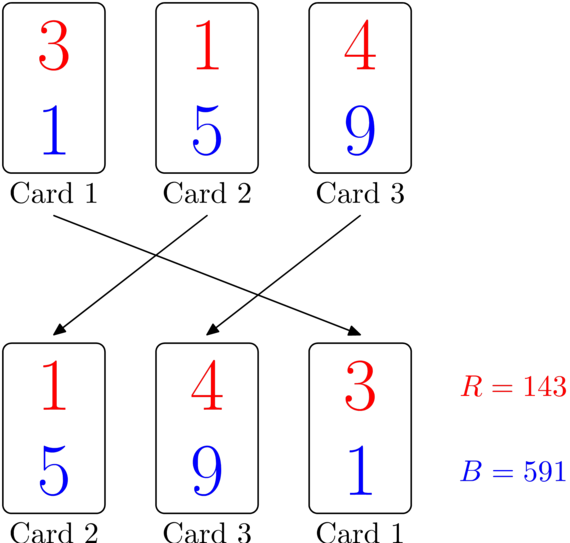CF1459A.Red-Blue Shuffle
普及/提高-
通过率:0%
AC君温馨提醒
该题目为【codeforces】题库的题目,您提交的代码将被提交至codeforces进行远程评测,并由ACGO抓取测评结果后进行展示。由于远程测评的测评机由其他平台提供,我们无法保证该服务的稳定性,若提交后无反应,请等待一段时间后再进行重试。
题目描述
There are n cards numbered 1,…,n . The card i has a red digit ri and a blue digit bi written on it.
We arrange all n cards in random order from left to right, with all permutations of 1,…,n having the same probability. We then read all red digits on the cards from left to right, and obtain an integer R . In the same way, we read all blue digits and obtain an integer B . When reading a number, leading zeros can be ignored. If all digits in a number are zeros, then the number is equal to 0 . Below is an illustration of a possible rearrangement of three cards, and how R and B can be found.
 Two players, Red and Blue, are involved in a bet. Red bets that after the shuffle R>B , and Blue bets that R<B . If in the end R=B , the bet results in a draw, and neither player wins.
Two players, Red and Blue, are involved in a bet. Red bets that after the shuffle R>B , and Blue bets that R<B . If in the end R=B , the bet results in a draw, and neither player wins.
Determine, which of the two players is more likely (has higher probability) to win the bet, or that their chances are equal. Refer to the Note section for a formal discussion of comparing probabilities.
输入格式
The first line contains a single integer T ( 1≤T≤100 ) — the number of test cases.
Descriptions of T test cases follow. Each test case description starts with a line containing a single integer n ( 1≤n≤1000 ) — the number of cards.
The following line contains a string of n digits r1,…,rn — red digits on cards 1,…,n respectively.
The following line contains a string of n digits b1,…,bn — blue digits on cards 1,…,n respectively.
Note that digits in the same line are not separated with any delimiters.
输出格式
Print T answers for the test cases in order, one per line.
If Red has a strictly higher change to win, print "RED".
If Blue has a strictly higher change to win, print "BLUE".
If both players are equally likely to win, print "EQUAL".
Note that all answers are case-sensitive.
输入输出样例
输入#1
3 3 777 111 3 314 159 5 09281 09281
输出#1
RED BLUE EQUAL
说明/提示
Formally, let nR be the number of permutations of cards 1,…,n such that the resulting numbers R and B satisfy R>B . Similarly, let nB be the number of permutations such that R<B . If nR>nB , you should print "RED". If nR<nB , you should print "BLUE". If nR=nB , print "EQUAL".
In the first sample case, R=777 and B=111 regardless of the card order, thus Red always wins.
In the second sample case, there are two card orders when Red wins, and four card orders when Blue wins:
- order 1,2,3 : 314>159 ;
- order 1,3,2 : 341>195 ;
- order 2,1,3 : 134<519 ;
- order 2,3,1 : 143<591 ;
- order 3,1,2 : 431<915 ;
- order 3,2,1 : 413<951 .
Since R<B is more frequent, the answer is "BLUE".
In the third sample case, R=B regardless of the card order, thus the bet is always a draw, and both Red and Blue have zero chance to win.